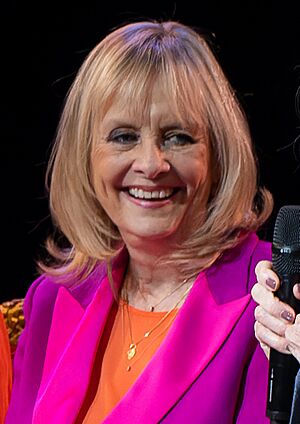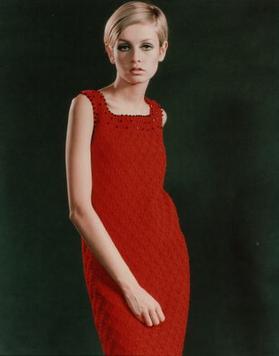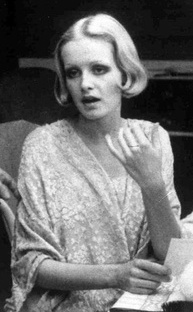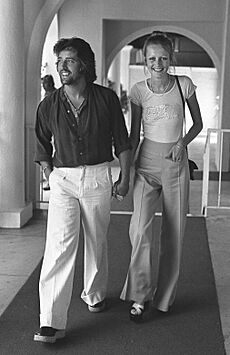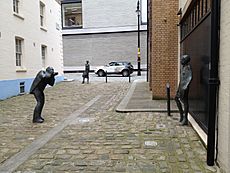Twiggy facts for kids
Dame Lesley Lawson, known to everyone as Twiggy, was born on September 19, 1949. She is a famous English model, actress, and singer. Twiggy became a huge fashion icon for teenagers in London during the exciting 1960s.
Twiggy first became famous for her very thin body and unique look. She had big eyes, long eyelashes, and short hair. In 1966, the Daily Express newspaper called her "The Face of 1966." She was also voted British Woman of the Year. By 1967, she was modeling all over the world, including France, Japan, and the US. She appeared on the covers of popular magazines like Vogue and The Tatler. Her fame quickly spread everywhere.
After her modeling career, Twiggy became a successful actress in movies, on stage, and on TV. She won two Golden Globe Awards for her role in the movie The Boy Friend (1971). In 1983, she performed on Broadway in the musical My One and Only. For this, she was nominated for a Tony Award for Best Actress. Later, she hosted her own TV show, Twiggy's People, where she interviewed celebrities. She also appeared as a judge on the reality show America's Next Top Model. Her book, Twiggy in Black and White, became a best-seller in 1998. Since 2005, she has modeled for Marks and Spencer, a big British store. Many people say she helped the company become successful again.
Contents
Early Life and Childhood
Lesley Hornby was born on September 19, 1949. She grew up in Neasden, which is now part of north-west London. She was the third daughter of Nellie Lydia, who worked in a printing factory, and William Norman Hornby, a carpenter. Her oldest sister, Shirley, was born 15 years before her, and her other sister, Vivien, was born 7 years before her.
Twiggy's mother taught her how to sew when she was young. Twiggy used this skill to make her own clothes. She went to Brondesbury and Kilburn High School.
Becoming a Supermodel (1965–1970)
Twiggy is known as one of the first international supermodels and a fashion icon of the 1960s. She looked up to Jean Shrimpton, who she believes was the world's first supermodel. Twiggy has said her famous "look" was inspired by Pattie Boyd. Many people see Twiggy as the next big model after Shrimpton.
How Twiggy Became Famous
In January 1966, when Twiggy was 16, she got her hair colored and cut short at a famous salon in London called Leonard of Mayfair. The hairdresser, Leonard, wanted to try out a new short haircut on models. He styled Twiggy's hair for some test photos. A professional photographer, Barry Lategan, took pictures for Leonard. The hairdresser displayed these photos in his salon.
A fashion journalist named Deirdre McSharry from the Daily Express saw the pictures and wanted to meet Twiggy. McSharry arranged for more photos to be taken. A few weeks later, the newspaper published an article and pictures of Twiggy. They called her "The Face of '66." The article said she was "The Cockney kid with a face to launch a thousand shapes... and she's only 16."
Twiggy's career took off very quickly. She was shorter than most models at 5 feet 6 inches. She weighed about 6.5 stone (around 41 kg or 91 lbs). Her body measurements were 31–23–32 inches (79–58–81 cm). She had a new, slim, and boyish look that was very popular. Her boyfriend, Nigel Davies, became her manager. He changed his name to Justin de Villeneuve and convinced her to change her name to Twiggy. "Twigs" was her childhood nickname because she was so thin.
Justin de Villeneuve often said he discovered Twiggy and was responsible for her success. However, in her 1998 book Twiggy In Black and White, Twiggy said she met Justin through his brother. She worked at a hair salon on Saturdays and saw models in magazines. She never thought she could be like them. Her idol was Jean Shrimpton, and she even grew her hair long to look like her before cutting it for her famous headshots. De Villeneuve managed her career for seven years, handling her money and projects during her most famous modeling years.
Twiggy soon appeared in all the top fashion magazines. She earned a lot of money, about £80 an hour. In 1967, she even launched her own clothing line called "Twiggy Dresses." She became incredibly famous in the fashion world. Twiggy once said, "I hated what I looked like, so I thought everyone had gone stark raving mad." Twiggy's look was known for three things: her very thin body, her short, boyish haircut, and her striking dark eyelashes. She often used three layers of false eyelashes to create her signature eye look.
Just one month after the Daily Express article, Twiggy did her first photo shoot for Vogue. She has appeared on the cover of Vogue (and its international versions) 14 times.
Global Fame (1967–1970)
Twiggy arrived in New York City in March 1967. Her arrival at Kennedy Airport was a big news event. Magazines like The New Yorker, Life, and Newsweek wrote about the "Twiggy phenomenon" in 1967. The New Yorker even dedicated almost 100 pages to her. That year, she became famous worldwide. She modeled in France, Japan, and America. She appeared on the cover of Paris Vogue in May, and on the cover of US Vogue three times (in April, July, and November). She was also on the cover of British Vogue in October.
In 1967, an article in Vogue described her as an "extravaganza that makes the look of the sixties." Twiggy was seen as a major symbol of Britain that year. America loved the hype, buying Twiggy pens, lunch boxes, eyelashes, and many Twiggy-endorsed makeup products.
The Metropolitan Museum of Art's 2009 exhibition catalog, The Model as Muse: Embodying Fashion, explained Twiggy's impact: "Twiggy's young body was perfect for the boyish styles that became popular in the 1960s. This trend included simple A-line dresses with collars, suits and dresses inspired by military uniforms, and even women's tuxedos by designers like Yves Saint Laurent. At the same time, 'unisex' designs like Nehru suits and space-age jumpsuits were created by designers such as Pierre Cardin and Andre Courreges."
Many famous photographers took pictures of Twiggy, including Cecil Beaton, Richard Avedon, Melvin Sokolsky, Ronald Traeger, Bert Stern, Norman Parkinson, Annie Leibovitz, and Steven Meisel.
Public Reaction to Twiggy
Twiggy and the magazines that featured her caused a lot of discussion. Her very thin, boyish image was, and still is, sometimes criticized for possibly promoting an "unhealthy" body ideal for women. Su Dalgleish, a fashion writer for the Daily Mail, said, "Twiggy came along when teenagers had more money to spend than ever before. With that undeveloped, boyish figure, she is an idol to 14- and 15-year-old kids. She makes virtue of all the terrible things of gawky, miserable adolescence."
However, Twiggy also had many supporters. Diana Vreeland of Vogue said, "She's no flash in the pan. She is the mini-girl in the mini-era. She's delicious looking." In recent years, Twiggy has spoken out against models being too thin. She explained that her own thinness as a teenager was natural: "I was very skinny, but that was just my natural build. I always ate sensibly – being thin was in my genes."
On December 10, 1969, even though she was 20 years old, Twiggy was featured on one of the first episodes of the TV show This Is Your Life by Thames Television.
Acting, Singing, and TV Career
Starting a New Path (1970–1979)
After four years of modeling, Twiggy stopped in 1970. She said, "You can't be a clothes hanger for your entire life!" She ended her business relationship with Justin de Villeneuve, who had managed her since 1966. She later said that her career was more about "that famous picture of her with those funny painted eyelashes, which appeared in the Daily Express under the headline 'The Face of '66'" than his efforts.
Twiggy has often said that people mostly remember her for modeling, even though it was "only a short part of my life." She became interested in movies by visiting director Ken Russell's house every week. They would watch old films with stars like Greta Garbo and Clark Gable. This changed how Twiggy dressed and wore her hair. She started wearing berets, longer skirts, and flowers as the hippie style became popular in London. Ken and Twiggy worked together on a movie called The Boy Friend (1971).
Twiggy then started acting and singing. She starred in many roles on stage and screen and recorded albums. In 1971, she made her movie debut as an extra in Ken Russell's The Devils. The same year, she played her first main role as Polly Browne in Russell's movie The Boy Friend. This movie was her first time working with Tommy Tune. She won two Golden Globe Awards in 1972 for this role. Also in 1971, Twiggy released a song called "Zoo de Zoo Zong." In 1974, she performed on the West End stage in Cinderella. She also made another movie, the thriller W, with her future husband Michael Witney. She also hosted her own British TV show called Twiggs.
In 1973, she appeared with David Bowie on the cover of his album, Pin Ups. This album became very popular in the UK. Bowie also mentioned her in his song "Drive-In Saturday" from his Aladdin Sane album.
In October 1975, she sang at a live concert for Roger Glover's album The Butterfly Ball and the Grasshopper's Feast at the Royal Albert Hall in London. The concert was filmed and released in cinemas. In November 1976, she appeared on The Muppet Show, where she sang the Beatles song, "In My Life". In 1976, she signed with Mercury Records and released two albums, Twiggy and Please Get My Name Right. These albums included pop and country songs. Twiggy sold very well, reaching No. 33 on the UK charts and earning a silver disc for good sales. The album also had Twiggy's hit song, "Here I Go Again." "Please Get My Name Right" reached No. 35 in 1977. Twiggy also sang some songs in the first Captain Beaky and His Band album in 1977.
In 1978, a TV show called Twiggy's Jukebox was created for the US. It featured musical performances with Twiggy as the host. Twiggy appeared in the movie "There Goes the Bride" with Tom Smothers in 1979.
Continuing Her Career (1980–1999)
In 1980, Twiggy had a small role in The Blues Brothers. In 1981, she starred as Eliza Doolittle in the TV production of Pygmalion. In 1983, she made her Broadway debut in the musical My One and Only. She was nominated for a Tony Award for her performance. She acted with Robin Williams in the 1986 comedy Club Paradise. In 1987, she played a performer in the British TV special The Little Match Girl. In 1988, she had a supporting role in Madame Sousatzka with her second husband, Leigh Lawson. In 1989, she played Hannah Chaplin, the mother of Charles Chaplin, in the British TV movie Young Charlie Chaplin.
In 1991, she co-starred in her first American TV series, the sitcom Princesses. Later, her Princesses co-star, Fran Drescher, spent time with Twiggy and her family in England. Drescher used Twiggy's husband, Leigh Lawson, as inspiration for the character Maxwell Sheffield in her hit show The Nanny.
In 1993, Twiggy appeared with Mark Hamill in a horror TV movie called Body Bags. In 1994, Twiggy was a guest star in the first Christmas special of Heartbeat, playing Lady Janet Whitley.
In 1997, Twiggy acted in a play called Blithe Spirit. A year later, she played Gertrude Lawrence in a stage show called Noel and Gertie. In 1999, she returned to the New York stage in a show called If Love Were All.
Recent Work (2000–Present)
In 2001, Twiggy co-hosted the British TV show This Morning. In 2003, she released another album, Midnight Blue. This album included many songs that had not been released before. In 2005, she joined the TV show America's Next Top Model as one of the four judges. A year later, she appeared on the cover of Swindle magazine's "Icons" issue. She also started modeling again for Marks & Spencer, appearing in TV ads and print. Her work in these ads is believed to have helped Marks & Spencer become successful again.
In 2006, she played herself as a 19-year-old in a radio play called Elevenses with Twiggy. She did not return to America's Next Top Model for its tenth season because of other work. In 2007, an album Twiggy recorded in 1979, Heaven in My Eyes ["Discotheque"], was finally released. In 2008, she supported the "Fashion Targets Breast Cancer" campaign. She also appeared in Marks & Spencer's 2008 Christmas ad campaign with other famous people.
In 2009, the beauty company Olay launched an ad campaign featuring Twiggy. There were some discussions about whether the image was too airbrushed. The company admitted to some minor changes and replaced the image.
Twiggy Today (2010–Present)
Twiggy continues to be a fashion leader for women her age. She remained part of the Marks & Spencer fashion team in 2009–2010.
In 2010, she launched her own fashion line called "Twiggy London" on the Home Shopping Network.
On November 21, 2011, she released an album called Romantically Yours. This album featured classic pop and easy listening songs. It included songs like "Bewitched, Bothered and Bewildered" and "Blue Moon". Her daughter, Carly Lawson, sang with her on one song. In 2012, she worked with Marks & Spencer designers to create her own clothing collection. In 2016, old pictures of Twiggy were used for Tod's Fall/Winter campaign.
On November 22, 2022, actress and filmmaker Sadie Frost worked with Twiggy to create a virtual documentary about Twiggy's life. On May 16, 2023, the final part of the documentary was made live at the Cannes Film Festival. They used special technology to create a realistic virtual version of London's Carnaby Street from the 1960s. This allowed people to interact with elements based on Twiggy's memories.
A musical based on Twiggy's life, called Twiggy The Musical, was written and directed by Ben Elton. It first opened in London in September 2023. It is planned to tour the UK starting in September 2025.
Honors and Awards
Twiggy was made a Dame Commander of the Order of the British Empire (DBE) in the 2019 New Year Honours. This honor was given for her contributions to fashion, the arts, and charity work. Her award was announced under her married name, Lesley Lawson.
Personal Life
Twiggy married American actor Michael Witney in 1977. Their daughter was born in 1978. They were married until Michael's death in 1983.
She met Leigh Lawson in 1984. In 1988, they worked together on the film Madame Sousatzka and got married that same year. The couple lives in Kensington, London and also has a home in Southwold, Suffolk.
On her official website, Twiggy says she supports breast cancer research, animal welfare, and campaigns against using animal fur in fashion. She was one of many celebrities who designed and signed a card for the UK charity Thomas Coram Foundation for Children. These cards were sold to raise money for the charity.
Filmography
Movies
| Year | Title | Role |
|---|---|---|
| 1971 | The Devils | Woman |
| The Boy Friend | Polly | |
| 1974 | W | Katie Lewis |
| 1980 | The Blues Brothers | Chic Lady |
| There Goes the Bride | Polly Perkins | |
| 1985 | The Doctor and the Devils | Jennie Bailey |
| 1986 | Club Paradise | Phillipa Lloyd |
| The Little Match Girl | Josie Roberts | |
| 1988 | Madame Sousatzka | Jenny |
| The Diamond Trap | Det. Sgt. Charlie Lawson | |
| Sun Child | Fen Harris | |
| 1990 | Istanbul (Keep Your Eyes Open) | Maud |
| 1993 | Body Bags | Cathy Matthews |
| 1997 | Something Borrowed, Something Blue | Eve Hamel |
| 1998 | Brand New World | Viv |
Television Shows
- Twiggs (1974)
- Twiggy (1975)
- The Muppet Show (1976)
- Victorian Scandals (1976)
- Bing Crosby's Merrie Olde Christmas (1977)
- The Hanna-Barbera Happy Hour (1978)
- The Donna Summer Special (1980)
- A Gift of Music (1981)
- Pygmalion, Eliza Doolittle (1981)
- Young Charlie Chaplin (1989)
- Princesses (1991)
- Tales from the Crypt (1992)
- The Nanny (1994)
- Heartbeat (1994)
- Absolutely Fabulous (2000–2001)
- This Morning (presenter) (2001)
- Take Time With Twiggy (host) (2001)
- America's Next Top Model (judge, cycles 5–9) (2005–2007)
- ShakespeaRe-Told: The Taming of the Shrew (2005)
- Friday Night with Jonathan Ross (guest) (2008)
- Twiggy's Frock Exchange (2008)
- Alan Titchmarsh's Walks of Fame (2010)
- Who Do You Think You Are? (2014)
- The People's History Of Pop (host) (2016)
- RuPaul's Drag Race UK (judge) (2019)
Stage Performances
- Cinderella, London (1974)
- The Butterfly Ball and the Grasshopper's Feast, London (1975)
- Captain Beaky and His Musical Christmas, London (1981)
- My One and Only, New York (1983–1984)
- Blithe Spirit, Chichester (1997)
- Noel and Gertie, New York (1998)
- If Love Were All, New York City (1999)
- Blithe Spirit, New York (2002)
- Mrs. Warren's Profession, England tour (2003)
Music Albums
- The Boyfriend (Original Soundtrack) (1971)
- Twiggy and the Girlfriends (1972)
- Twiggy (1976)
- Please Get My Name Right (1977)
- Captain Beaky and His Band (1977)
- My One and Only (with Tommy Tune) (1983)
- Midnight Blue (2003)
- Heaven In My Eyes – Discotheque (2007)
- Gotta Sing Gotta Dance (2009)
- Romantically Yours (2011)
Books and Exhibitions
- Twiggy, Twiggy: An Autobiography (1975)
- Twiggy, Twiggy's Guide to Looking Good (1986)
- Twiggy, Twiggy in Black and White (1997)
- Twiggy, Twiggy: Please Get My Name Right (2004)
- Twiggy, A Guide to Looking and Feeling Fabulous Over Forty (2008)
- Twiggy: A Life in Photographs, National Portrait Gallery (2009–2010)
See also
 In Spanish: Twiggy para niños
In Spanish: Twiggy para niños


